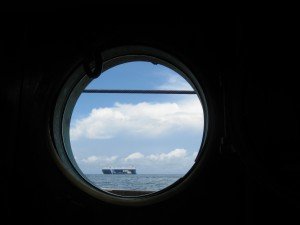
For the nearly five years that we’ve been living full-time aboard Ganymede, our lighting situation has been a never-ending saga. Being a boat without 12-volt electricity plumbed in, we naturally turned to oil lamps for cabin lighting. We had saved three already out of our beloved little Capella—the first boat we owned and cruised in—so it was not too bad to buy two more gimballed cabin lamps for a total of four in the salon and one above the berth. The salon four were from the Den Haan lampmakers in Rotterdam; the one for the berth a smaller one from Weems & Plath. We were also given a huge Trawler hanging lamp, which while it gave an enormous amount of light was far too big for the cabin, and we jettisoned it at the first swap meet we went to in La Paz.

Now the thing about oil lamps is that they burn oil—paraffin or kerosene (or mineral spirits, in a pinch), and paraffin can become expensive, not to mention hard to find in certain far-flung places. We had managed to always keep a good, clean supply of paraffin in Capella, and the two lamps had shed more than enough light in the white-painted cabin to do almost anything by. But Ganymede, though her deckhead is white, has a lot more dark surfaces that propagate the light but poorly, and is also far bigger inside. So she was already harder to light properly, and a tragic intrusion of water into our oil supply, early on in the cruise, rendered it less efficient than it ought to have been.

It took longer than it should have to discover that our paraffin supply was adulterated, and separating the water out was messy and time consuming. But then a worse problem arose. We were in remotest Mexico, heading into even more wildsome parts, when we began to need more lamp fuel. Paraffin (predictably) proved imposible to find, and the best we could get was a low-grade kerosene. To its credit there was lots of it, and it was pretty cheap, but it needed no outside intrusion of water to make it unsuitable for burning. Not that it wouldn’t burn; it certainly would, but dimly and with a powerful choking odor and a black smoke that put smut all over the deckhead and dropped bits of soot here and there out of the sky. It hardly mattered by that point, since we were in latitudes too hot to want to light oil lamps much, and our huge supply of Mexican Mix lasted until long after we had returned to the ‘States on the other side of the Panama Canal.

Our first winter back ‘stateside finally saw the end of the smutty Mexican kerosene, but the odorless, smokeless paraffin suitable for lamps was more expensive than ever, so I tried out the kerosene sold in bulk as heating oil. Though it was unmistakeably better, it still guttered more than was seemly, and we continued to burn wicks up at an astonishing rate. Along with it our lamps developed a new quirk: even when not filled much above half, the kerosene would wick itself out and trickle down the body of the lamp to drip on the upholstery, the wood stove, and whatever we were cooking on the range. Not fast, mind you, but enough to fill the boat with an everpresent aroma of kerosene, and make Danielle throw out whatever food it may have landed on. This was puzzling, since it had never happened on Capella, and seemed to become more prevalent as time went by. It was moreover heartily annoying, and added to the expense and fragility of the chimneys….

But let me turn aside and talk about lamp chimneys for a while. I can hardly believe that a lamp chimney is more difficult or expensive to make than a common water tumbler, yet West Marine wants $36 apiece for Den Haan chimneys! Weems & Plath, not to be outdone, gets $18 for each of theirs, which are far smaller and crack more easily from the heat of the flame. Often a chimney will rend itself in pieces with the heat of the first use, and one evil night saw three brand-new Den Haan chimneys shatter themselves asunder just moments after being put on the lamps. One could wish that for $36 apiece they could make the things out of tempered glass, at least! For a company that claims to have been making lamps for over a hundred years it seems they still have a ways to go. I had begun to despair of affording to light my boat at all when I stumbled across Southern Lamp Supply on the internet and discovered that they sell globes that fit the Den Haan lamps for $6 each. Not that these don’t shatter just as readily and randomly, but you get six colossal failures for the price of one.

But back to adding the expense of chimneys to the bother of dripping kerosene (which by the way is a design flaw of the Den Haan gimbaled cabin lamps. The little Weems & Plath Atlantic lamp has never dripped a drop), I was about to just put candles in all the gimbals and be content when some clean-burning, lamp-ready kerosene came our way. Danielle tried it out, and the results were night-and-day. Not only did the flame burn brighter and cleaner, there was no smell, and the lamps ceased to drip. After a few days of use, she noticed that the wicks had needed far less trimming, and the chimneys didn’t soot up to a dingy, perpetual gray if they lasted unbroken more than a week.
So the lamps are back in our good graces, and though there’s still much room for improvement, especially along the lines of sturdier chimneys, it seems that a lot of the tribulations of oil lamp use can be mitigated by coughing up the extra money for nicer fuel. Not only do they burn brighter, they dispel moisture and warm up a brisk evening without creating a choking fug in the cabin. Strange to think that in the four++ years of daily life aboard we’ve only just now had a chance to let our little lamps shine to their full potential. I wonder what else we’ve been missing all this time?